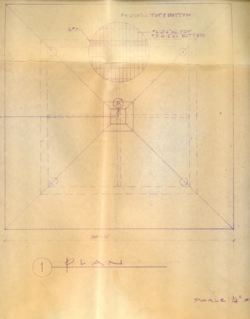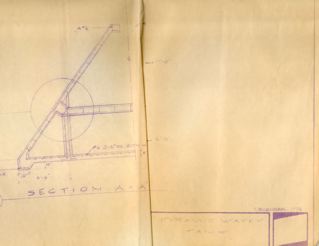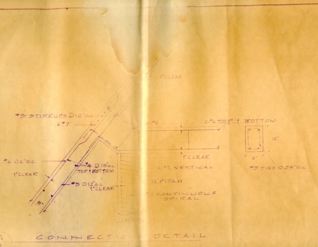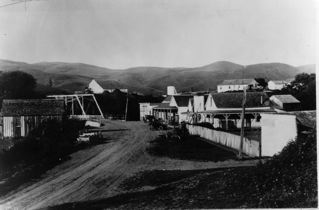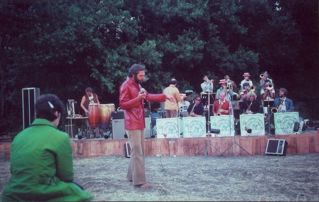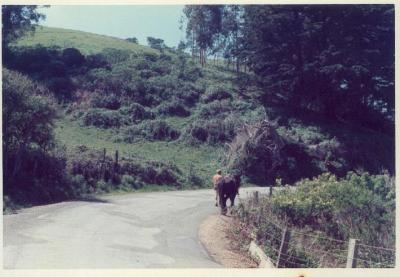planned to build a pyramid water tank on top of a little hill near Stage Road. I’m talking about the 1970s. Palm trees would be planted next to the tank. One palm tree was planted but the pyramid water tank did not appear. Here are the plans that I now see have faded with age– well, use your imagination, you know what a pyramid looks like!
A Confusing Paper Trail: Part IV Conclusion
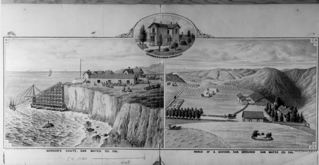 (Photo: County Supervisor Alexander Gordon became one of the defendants in the San Gregorio Rancho case. This 1870s illustration was made on site, showing “Gordon’s Chute” at Tunitas Creek, the countryside and Gordon’s home]
(Photo: County Supervisor Alexander Gordon became one of the defendants in the San Gregorio Rancho case. This 1870s illustration was made on site, showing “Gordon’s Chute” at Tunitas Creek, the countryside and Gordon’s home]
The most notorious legal contest was yet to come as the “famous San Gregorio Rancho case” was brought before the San Francisco Superior Court in 1872. Who were the legal owners?
The “San Gregorio Rancho case” dragged on for a decade and affected prominent men–among them County Supervisor Alexander Gordon who built the fantastic, but ill-fated, “Gordon’s [shipping] chute” at Tunitas Chute.
Judge Hunt unraveled the convoluted events and found that Antonino Buelna left a will granting two minor heirs a fifth interest in the Rancho San Gregorio. These heirs sold their interest to Hugh Hamilton–who then resold it. Later, ignoring the sale to Hamilton, the heirs sold their interest again!
The whole thing was finally settled in favor of the defendants, including Alexander Gordon.
Attached to the original, yellowed document that relates the story I just told you–is label that reads: “1247 San Gregorio R. formerly Santa Cruz County now in San Mateo Co.” Perhaps this document was entered as evidence in the famous San Gregorio Rancho case.
Possibly it was simply a detailed records of land transactions of the Rancho San Gregorio. The document covers critical years in California and Coastside history. California became a state and the rancheros were driven out…..
Photo: San Mateo County History Museum. Please visit the museum’s new exhibits at the historic Redwood City Courthouse in Redwood City.
A Confusing Paper Trail: Part III

Francisco Casanueva, the Chilean businessman, divided the rancho into parcels sold to Americans including James Bell, Henry Wilkins nd Hugh Hamilton.
Hamilton is credited as an early American settler. He lived in a large frame house that once stood on the north bank of San Gregorio creek. An 1860 official survey map shows a fence belonging to him. It is also said tht when he arrived in San Gregorio he “saw tht the land was mixed-up,” perhaps implying that he knew title to property there was not clear.
James Bell– whose descendants went into the hotel business in San Gregorio–was a highly respected pioneer who had a post office called Bellvale named in his honor.
In the early 1860s Concepcion received her patent from the Land Commission in San Francisco–but it was too late as the land had changed into the hands of the Americans.
…To Be Continued….
A Confusing Paper Trail: Part II
In 1839, California Governor Alvarado granted four- square leagues of the Rancho San Gregorio to Antonino Buelnaâwho was busy âfighting Indians and foreigners in the San Joaquin.â?
Life seemed uncomplicated and no one bothered with the details of an official land survey. The Rancho San Gregorio was simply described as being bordered âon the west by the Arroyo de los Lobitos, on the north by the Sierra Grande, on the east by the land owned or claimed by Fran Gonzales and on the south by the Pacific Ocean.â?
Seven years later in 1846– after Mexico went to war with the United StatesâAntonino Buelna died, leaving a widow and a daughterâ¦but according to the document, Buelnaâs last will did not clearly specify how the estate was to be dispersed. That could have delayed legal transfer of the property but it did not stop hasty and questionable land transactions.
Buelnaâs relatives sold pieces of the valuable propertyâtheir names appear on the document.
In the interim, Antoninoâs widow, Concepcion, married Francisco Rodriquez. In 1851, Rodriquez failed to pay $118.12, the amount of state and county taxes due on the rancho. As a result of non-payment, the rancho went up for sale at a public auction. Strangely, the highest biddersâWilliam Baker of Massachusetts and his attorney J. L. Majorsâpicked up the rancho for a scant $118.12, the exact amount of taxes due.
Baker and Majors turned around and sold the land to Chilean businessman Francisco Casanueva for $10,000.
The yellowing document revealed yet another transaction, this time between Buelnaâs widow, Concepcion, and the Chilean businessman.
Confused? So am I.
Concepcion also applied for a patent on the rancho from the U.S. Land Commission Secretary in San Francisco.
Is it possible that the same land was sold twice? As to whatever actually happened and who paid whom, and for what reasons, the document paints a confusing picture.
â¦To be Continuedâ¦
A Confusing Paper Trail: Part I
 (Photo: The gateway to early San Gregorio).
(Photo: The gateway to early San Gregorio).
Is it possible that the same land was sold twice? As to whatever actually happenedâand who paid whomâand for whatever reasonsâan intriguing document painted a confusing picture.
The document revealed the handwriting of one person using pen and ink on legal-sized paper. The paper had yellowed and turned brittle with age and a chunk had been chewed out of the right margin. A heavy-duty string bound the fragile papers together.
The folder contained âevidenceâ? of a confusing story that pointed to shady dealings over the ownership and sale of the original 17,800-acre Rancho San Gregorio, south of Half Moon Bay.
Covered were transactions occurring between 1853 and 1861âa tumultuous period in Californiaâs history when land was fast changing hands from the rancheros to the American gringos.
â¦To Be Continuedâ¦
Photo: San Mateo County History Museum located in the historic Redwood City Courthouse.. Please visit the museum and research your favorite subject in the archives.
Once–The Most Recognizeable Backside in San Gregorio/Pescadero
In San Gregorio, in the 1970s, the members of the band, “Full Faith & Credit”, featuring singer Michael Schwab. Michael lived at the worm farm.
Two guests at the concert: (At left) former El Granada contractor Doug St. Denis with unidentifed man.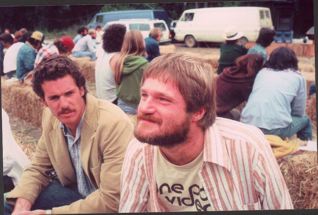

=====================================================================
hello to jerry koontz!!!
peter adams , laguna beach
Babaji Comes To The Coastside (1975) Part III
According to Miramar Beach kayak enthusiast and photographer, Michael Powers, most of the Coastsiders “were curious and interested” about Babaji’s visit to the farm at San Gregorio.
What he captured on film were “a lot of kids and ‘flower children’ running all over the place. Fresh fruit and blossoms were placed at the master’s feet,” said Powers. “It was theatrical and wonderfully staged. There was a genuine feeling of generosity, of spirituality.”
One Coastside source–who recounted her experience on the condition that I not use her name–said she wore a leaf green tunic with rust-orange stripes and white muslin pants. “I wanted to wear something loose and comfortable,” she told me. “I had seen many photos of the Beatles and the Maharaja and I based my outfit on that image.”
Then a resident of San Gregorio, this source also recalled meeting Babaji as he ascended the hill.
“I was introduced to him,” she recalled. “The white robes told me he was someone to be revered. I wondered if it was good luck to shake his hand. It put me in a good mood.”
When Babi Hari Dass arrived, he was accompanied by some 50 of his followers from Santa Cruz, all of them wearing white and ecru gauzy fabrics. Some of them held strands of sandalwood beads. Michael Powers noted that the followers tended to be “fanatic and committed.”
With a peaceful smile on his face, Babaji sat cross-legged on the Indian rug beneath an orange parachute. All eyes turned to watch the tanned and barefooted young woman in the green and white sarong drop a fresh bouquet of wildflowers at the master’s feet.
…To be continued…
Note: I have misplaced a lovely color photo of Babaji taken at the San Gregorio Farms event.I’ll post it when I find it–the photo really helps define the story.
“Babagi” Comes To The Coastside (1975) Part II
The Astanga Yoga that he practiced also embraced meditation, posture discipline as well as a vegetarian diet. Santa Cruz resident Peggy Bazarnick, an ardent follower for 15 years, told me in 1993 that Babji “stresses the right way of living. That means not harming anyone, caring for the body, while not being attached to the body.”
Peggy added that during private interviews “he never tells anyone what to do. He knows everything; he looks right through you and knows all. He will offer you options but he will never tell you what you should do.”
In 1971 the Hunuman Foundation, a California group, made the arrangements which brought Babi Hari Dass from India to Santa Cruz where he settled.
Not everyone in the tiny village of San Gregorio was pleased about the coming of the spiritual teacher.
“Dick the Gardener”, the tall, reclusive, awkward young man who lived on the worm farm, grumbled bitterly when the lower field was plowed for the festivities. A Cornell University graduate, he dropped out of the academic scene to pursue an alternative lifestyle.
“Dick the Gardener” leased a patch of land became locally renown for the quality of the organic tomatoes, squash and garlic that prospered under his care.
He was cynical about the event; he felt certain that the outsiders would trample and destory his precious new tomato crop.
…To be Continued…
“Babagi” Comes To The Coastside Part I
In June of 1975, Babi Hari Dass, a spiritual teacher from India visited the Coastside. His appearance was later called “a visual spectacle, comparable to a scene from the movie, ‘Ghandi'”.
The “happening” took place in the lower field of what the locals called “the worm farm” at San Gregorio.
The “worm farmers” (who had traded the glitz of Los Angeles/Beverly Hills for the Coastside’s rustic serenity) were raising earthworms commercially in long, narrow, custom-built redwood planters in a small corner of the several hundred-acre ranch.
Not far from where the earthworms were burrowing in their special soil mixture in a scooped-out section of earth beside a creek, someone had unfurled a bright orange parachute. The colorful covering was protection for the 100 expected guests–a contrast of locals and devoted followers of Babi Hari Dass. They would sit on bales of hay or on pretty Oriental carpets that had been placed on the ground.
A statute of the goddess Kwan Yin, with one palm extended and open, the joined forefinger and thumb forming a circle on the other hand, conveyed a peaceful spirit among the pots of pink and white Sweet Williams.
Special care was taken by all to avoid treading on the large Indian rug, centrally located and reserved for the 51-year-old spiritual guest of honor.
Along with other Coastsiders, I was invited to meet and ask questions of “Babaji” (a term of respect). He was a short, kind-faced, bearded man wearing a long white robe. What was most unusual was that as a practitioner of Astanga Yoga, he had not spoken a word to anyone for 25 years.
“Babaji” communicated by writing on the little chalkboard strung around his neck–or when more words were necessary, he used the larger, portable chalkboard strung around his neck–or when even more words were necessary, he used the large, portable chalkboard that he carried with him.
…to be continued…
More of San Gregorio Farms in the 1970s…
…and its main crop, the agricultural earthworm 
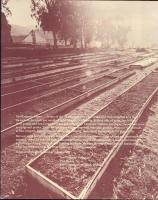 The bins were filled with the hybrid earthworms (and soil, of course)
The bins were filled with the hybrid earthworms (and soil, of course)
Photos: Below: Pouring cement for a new floor in one of the farm’s barns. 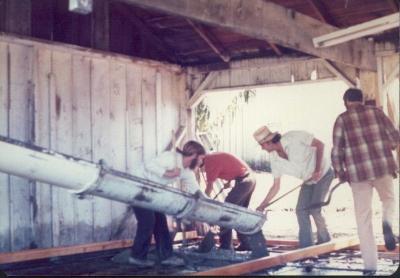
Center: 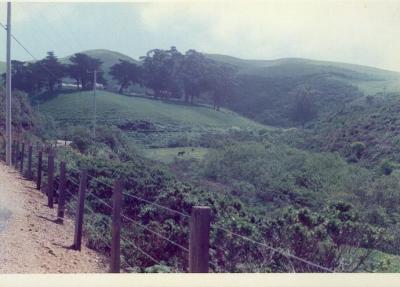 Beautiful view of the San Gregorio Ranch in the 1970s, today part of POST (Peninsula Open Space Trust).
Beautiful view of the San Gregorio Ranch in the 1970s, today part of POST (Peninsula Open Space Trust).

